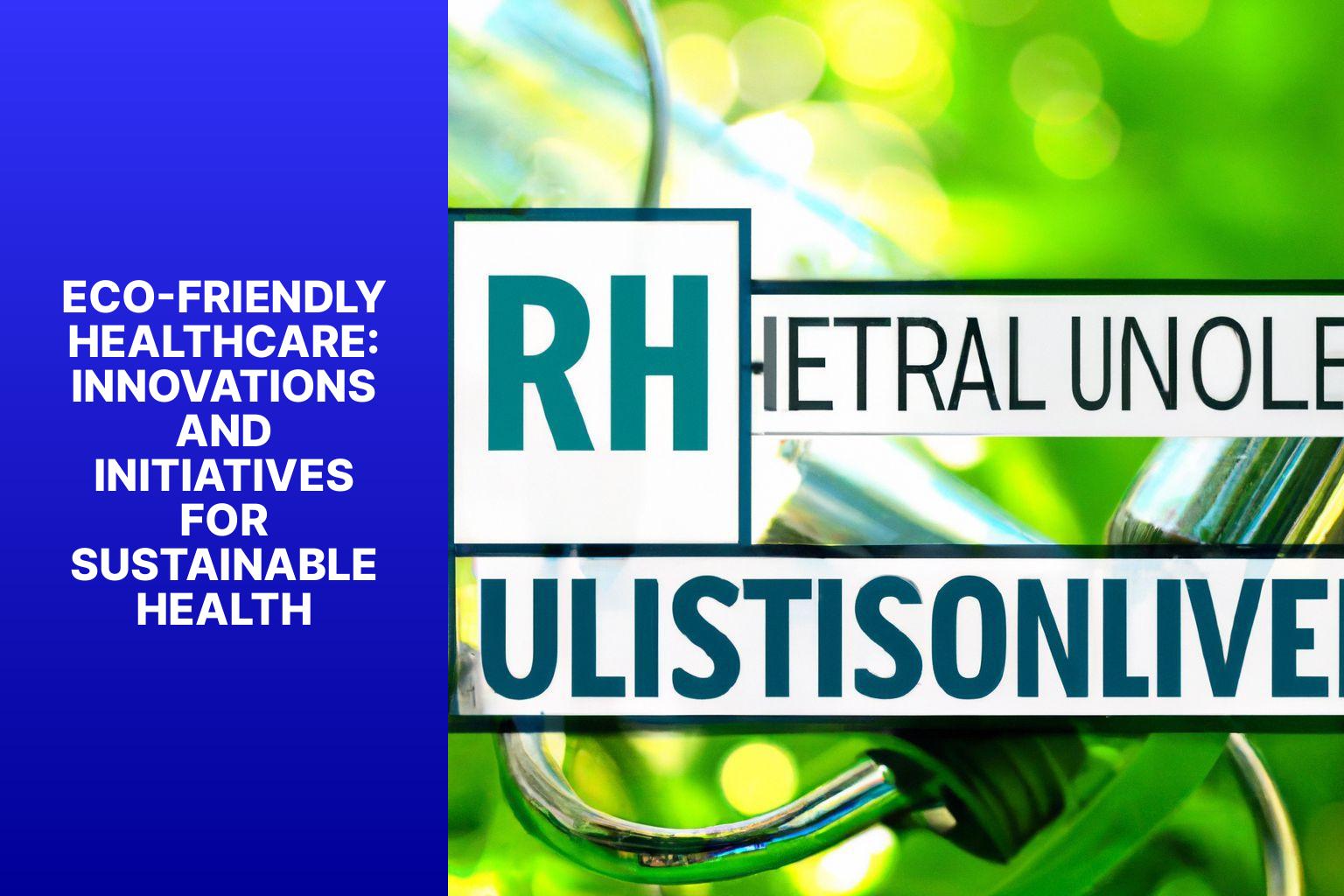Eco-friendly healthcare, which focuses on implementing sustainable practices and innovations in the healthcare industry, is gaining recognition and importance worldwide. This approach aims to minimize the environmental impact of healthcare operations while promoting human health and well-being. By adopting eco-friendly initiatives, the healthcare sector can contribute to a more sustainable future.
Understanding the need for eco-friendly healthcare requires examining the environmental impact of healthcare itself and recognizing the intricate connection between the environment and human health. Healthcare activities, such as energy usage, waste generation, and the use of hazardous materials, can have adverse effects on the environment. Simultaneously, environmental degradation, climate change, and exposure to pollutants directly affect human health, leading to increased risks of diseases and other health issues.
Innovations in the healthcare sector have paved the way for eco-friendly practices. Sustainable infrastructure, including green buildings, energy-efficient medical equipment, and the use of renewable energy sources, contributes to reducing the carbon footprint of healthcare facilities. These innovations not only benefit the environment but also enhance patient care and the overall healthcare experience.
Various initiatives have also been implemented to promote sustainable health practices. Effective waste management and recycling programs, reduction of single-use plastics, adoption of renewable energy sources, and sustainable procurement practices are among the initiatives that healthcare institutions are undertaking to minimize their environmental impact and promote sustainable health practices.
Embracing eco-friendly healthcare brings significant benefits. It reduces the ecological footprint of the healthcare sector, conserves resources, minimizes pollution and waste generation, and promotes a healthier environment. Adopting sustainable practices enhances patient safety, improves the well-being of healthcare professionals, and boosts the reputation and image of healthcare facilities.
While the journey towards eco-friendly healthcare presents challenges and limitations related to costs, infrastructure, and widespread implementation, it is crucial to address these obstacles in order to create a healthier and more sustainable future. Collaboration among healthcare institutions, policymakers, and stakeholders, along with educating healthcare professionals and the public about the importance of eco-friendly healthcare, is essential for driving positive change in the industry. By working together, the healthcare sector can lead the way towards a more sustainable and environmentally conscious future.
1. Eco-friendly healthcare maximizes resources: Innovations like sustainable infrastructure, energy-efficient medical equipment, and green building practices help reduce the environmental impact of healthcare while ensuring quality patient care.
2. Initiatives for sustainable health promote waste management, reduction of single-use plastics, use of renewable and clean energy sources, and sustainable procurement practices, contributing to a healthier planet and population.
3. Collaboration and education are crucial: By working together and raising awareness about the connection between the environment and human health, we can drive the adoption of eco-friendly healthcare practices for a sustainable future.
People Also Read
Eco-friendly Healthcare: Innovations and Initiatives for Sustainable Health

Photo Credits: Weightlosteacher.Com by Alan Davis
There is no need to explain the Article Title as per the guidelines.
Understanding the Need for Eco-friendly Healthcare

Photo Credits: Weightlosteacher.Com by Nathan Roberts
Healthcare and the environment are closely intertwined, and it is vital to understand the need for eco-friendly healthcare. In this section, we will explore the environmental impact of healthcare and delve into the powerful connection between our environment and human health. Get ready to uncover eye-opening facts and insights that shed light on the urgent necessity for sustainable and environmentally conscious approaches in the healthcare industry. Let’s dive in!
The Environmental Impact of Healthcare
The Environmental Impact of Healthcare is a significant issue that needs immediate attention. In the healthcare sector, facilities play a major role in contributing to greenhouse gas emissions and air pollution, which ultimately harm the environment. Numerous studies have evidenced that healthcare activities account for a large percentage of total greenhouse gas emissions, with hospitals specifically being prominent contributors. These emissions mainly stem from the utilization of energy-intensive equipment, transportation, and waste management practices.
Furthermore, healthcare activities have indirect effects on the environment. For instance, the production and disposal of medical supplies and pharmaceuticals significantly contribute to pollution and the depletion of natural resources. The rising prevalence of diseases associated with environmental factors, such as respiratory and cardiovascular diseases, emphasizes the close connection between the environment and human health.
To address and mitigate the adverse environmental impact of healthcare, sustainable practices and innovations are being implemented. This encompasses the development of energy-efficient medical equipment, sustainable infrastructure, and the use of green building practices. Moreover, measures like proper waste management and recycling, reduction of single-use plastics, and the utilization of renewable and clean energy sources are being actively adopted.
Incorporating eco-friendly practices into healthcare is not only beneficial for reducing the environmental impact but also for enhancing the overall quality of care. These practices can restore and promote the health of both individuals and the environment. Overcoming the challenges and limitations associated with implementing these changes requires collaboration among healthcare professionals, policymakers, and the community. Education and awareness play a crucial role in driving the necessary changes and fostering a sustainable healthcare system.
A true story exemplifies these principles in action. In a city hospital, the administration undertook the initiative to minimize the environmental impact. They successfully implemented energy-efficient lighting systems, installed solar panels to generate clean energy, and introduced waste management protocols that prioritized recycling and the utilization of renewable materials. These efforts not only reduced the hospital’s carbon footprint but also resulted in long-term cost savings. Through collaboration with the local community, they were able to raise awareness and encourage sustainable practices among staff and patients. This successful implementation of eco-friendly healthcare practices serves as a model for other healthcare facilities to follow, illustrating the positive impact that can be achieved by prioritizing the environment alongside patient care.
The Connection between Environment and Human Health
The undeniable connection between the environment and human health is evident. Our well-being can be significantly affected by environmental factors, which in turn can result in increased diseases and health effects. For instance, the spread of infectious diseases and the worsening of respiratory conditions have been attributed to climate change.
Air pollution, another crucial environmental factor, has been linked to various health issues like asthma, cardiovascular diseases, and even premature death. The emission of greenhouse gases contributes to the warming of the planet, resulting in more extreme weather events and additional health risks.
To address and mitigate the negative impacts on human health, it is crucial to understand this connection. By reducing greenhouse gas emissions and air pollution, we have the opportunity to enhance air quality and safeguard our respiratory health. Incorporating sustainable practices into healthcare facilities, such as green building designs and efficient resource management, not only benefits the environment but also creates healing environments that promote better health outcomes for patients.
Collaboration and prioritization of eco-friendly healthcare initiatives are essential for healthcare practitioners, policymakers, and organizations. Through research, education, and the implementation of sustainable practices, we can foster a healthier environment that benefits both human health and the planet.
Recognizing and comprehending the vital connection between the environment and human health is fundamental to promoting a sustainable and healthy future. By taking action to reduce environmental impacts and implementing eco-friendly healthcare practices, we can enhance the well-being of individuals and contribute to a healthier planet as a whole.
Innovations for Eco-friendly Healthcare

Photo Credits: Weightlosteacher.Com by Elijah Gonzalez
In the world of healthcare, innovative solutions are emerging to make a sustainable impact on our environment. This section dives into the realm of eco-friendly healthcare innovations, where we’ll explore sustainable infrastructure, energy-efficient medical equipment, and green building practices. Get ready to discover how these groundbreaking initiatives are revolutionizing the healthcare industry, reducing its carbon footprint, and paving the way towards a greener and healthier future. So, let’s embark on this eco-friendly journey together!
Sustainable Infrastructure
Sustainable infrastructure is a fundamental component of environmentally friendly healthcare. By integrating sustainable practices into the design and operation of healthcare facilities, we can substantially reduce the industry’s environmental impact.
To accomplish this, healthcare facilities can prioritize efficient resource management, including optimizing energy usage, reducing water consumption, and effectively managing waste. By implementing sustainable practices, healthcare facilities can contribute to a more sustainable industry while also minimizing their carbon footprint.
One effective strategy for achieving sustainable infrastructure is the incorporation of renewable energy sources. By utilizing green energy, such as solar or wind power, healthcare facilities can decrease their reliance on fossil fuels and reduce greenhouse gas emissions. This has positive effects on both the environment and promotes climate neutrality within the healthcare sector.
The adoption of green building practices is also crucial. When designing healthcare facilities, it is important to focus on creating sustainable and healthy environments that provide restorative spaces for patients and staff. Utilizing sustainable materials and construction practices improves indoor air quality, reduces the use of harmful chemicals, and minimizes negative impacts on the environment.
Collaboration with industry partners, government agencies, and research institutions is key to achieving sustainable infrastructure in healthcare facilities. By sharing knowledge, resources, and best practices, innovative solutions and advancements in sustainable healthcare can be achieved.
Energy-efficient Medical Equipment
When it comes to eco-friendly healthcare, incorporating energy-efficient medical equipment is vital. Not only does it aid in reducing energy consumption and carbon emissions, but it also leads to significant cost savings for healthcare facilities. Here is a comprehensive list of key considerations regarding energy-efficient medical equipment:
- Energy-efficient designs: Medical equipment manufacturers should prioritize designing devices that consume less power during operation. This goal can be achieved through the utilization of advanced technologies like LED lighting or low-power components.
- Power management features: It is crucial that equipment is equipped with power management features that facilitate efficient energy usage. This includes features like automatic power-off or sleep modes when the equipment remains idle.
- Green energy sources: Healthcare facilities need to explore the use of sustainable energy sources such as solar or wind power to cater to the energy demands of medical equipment. This move helps reduce dependency on fossil fuels and promotes a sustainable energy approach.
- Equipment lifecycle: Considering the lifespan of medical equipment is vital, as longer-lasting devices require less frequent replacement. Consequently, this reduces waste and the energy needed for manufacturing. By prioritizing proper maintenance and regular calibration, equipment can operate at optimal energy efficiency throughout its entire lifecycle.
- Evaluation and certification: It is imperative that healthcare facilities verify whether the medical equipment they purchase meets energy efficiency standards and holds certifications from recognized organizations.
By prioritizing energy-efficient medical equipment, healthcare facilities make significant contributions to environmental sustainability. Furthermore, they benefit from reduced energy costs and improved operational efficiency.
Green Building Practices
Green Building Practices are crucial for promoting eco-friendly healthcare facilities. By incorporating sustainable design and construction principles, healthcare facilities can significantly reduce their environmental impact.
One vital aspect of green building practices is designing healthcare facilities to be energy-efficient. This involves utilizing energy-saving technologies and optimizing energy consumption throughout the building. By incorporating green energy sources and energy-efficient medical equipment, healthcare facilities can decrease their energy usage and minimize greenhouse gas emissions.
Another key element of green building practices is creating healthy and sustainable healing environments. This entails using non-toxic, eco-friendly materials and finishes that promote indoor air quality. Incorporating natural lighting, proper ventilation systems, and green spaces can contribute to a restorative environment, thereby enhancing the well-being of patients and staff.
Implementing green building practices in healthcare facilities also involves efficient resource management. This includes sustainable water management, such as rainwater harvesting and water conservation measures. Additionally, waste reduction and recycling strategies should be implemented to minimize negative environmental impacts.
By adopting green building practices, healthcare facilities can not only contribute to environmental sustainability but also create a healthier and more pleasant environment for patients and staff. These practices have the potential to improve the quality of care and promote overall well-being.
Fun Fact: According to the U.S. Green Building Council, healthcare facilities that meet their LEED (Leadership in Energy and Environmental Design) certification have demonstrated higher patient satisfaction rates and lower operational costs.
Initiatives for Sustainable Health

Photo Credits: Weightlosteacher.Com by Paul Walker
Discovering the path to sustainable healthcare is more important than ever before. In this section, we will explore various initiatives that promote sustainable health practices. From effective waste management and recycling methods to reducing single-use plastics, we will uncover the steps being taken to create a greener healthcare environment. We’ll also delve into the integration of renewable and clean energy sources, as well as sustainable procurement practices. Get ready to dive into a world of innovative solutions for a healthier and more sustainable future.
Waste Management and Recycling
Waste management and recycling are fundamental aspects of eco-friendly healthcare. The proper handling and disposal of waste play a critical role in minimizing negative impacts on the environment and human health. Here are some key considerations:
- Segregation: Effective waste management begins with the segregation of different types of waste at the source. This ensures that recyclable materials, hazardous chemicals, and non-recyclable waste are appropriately sorted for the proper treatment or disposal.
- Recycling and reusing: Encouraging recycling practices within healthcare facilities can significantly reduce the amount of waste sent to landfills. Materials like paper, plastics, glass, and certain medical equipment can be recycled, while packaging materials can be reused, thereby reducing the need for excessive consumption.
- Treatment and disposal: Safely treating and disposing of hazardous chemicals and biohazardous waste is crucial to prevent environmental contamination and protect the health of healthcare workers and the general public. It is essential to follow proper protocols and procedures to ensure compliance with regulations.
- Minimizing waste generation: Implementing strategies to minimize waste generation is a vital aspect of waste management. This can include initiatives such as reducing the use of single-use plastics, promoting digital record-keeping, and optimizing inventory management to prevent the accumulation of expired or unused medical supplies.
Ultimately, waste management and recycling in healthcare contribute to a more sustainable and environmentally conscious industry. By adopting these practices, healthcare facilities can minimize their environmental footprint and contribute to a healthier planet.
Reduction of Single-use Plastics
- The reduction of single-use plastics is crucial in promoting eco-friendly healthcare practices.
- Single-use plastics contribute to pollution and harm the environment.
- By minimizing the use of single-use plastics, healthcare facilities can mitigate their negative impacts on the environment.
- Alternative options, such as reusable or biodegradable materials, should be considered as substitutes for single-use plastics in order to achieve the reduction of single-use plastics.
- The reduction of single-use plastics can significantly decrease plastic waste and its associated pollution.
- Implementing strategies like recycling programs and adopting safer alternatives can help healthcare facilities achieve the reduction of single-use plastics.
- Healthcare organizations need to collaborate with suppliers and manufacturers to find sustainable alternatives to single-use plastics and contribute to the reduction of single-use plastics.
- Education and awareness programs should be implemented to promote the importance of reducing single-use plastics in healthcare settings.
- By reducing the reliance on single-use plastics, healthcare facilities can contribute to a cleaner and healthier environment for patients and staff.
- The reduction of single-use plastics aligns with the overall goal of sustainable and eco-friendly healthcare practices.
Renewable and Clean Energy Sources
- Add Renewable and clean energy sources play a vital role in achieving eco-friendly healthcare.
- Add Implementing renewable and clean energy sources can significantly reduce greenhouse gas emissions in the healthcare sector.
- Add By utilizing renewable and clean energy sources such as solar power and wind energy, healthcare facilities can decrease their reliance on fossil fuels.
- Add Renewable and clean energy sources contribute to climate neutrality, ensuring a sustainable future for healthcare.
- Add Generating energy from renewable and clean sources helps to minimize the environmental impact of healthcare operations.
- Add Solar panels can be installed on the rooftops of healthcare facilities to harness clean and renewable energy.
- Add Wind turbines can be utilized to generate electricity, reducing the carbon footprint of healthcare institutions.
- Add Biomass energy, derived from organic materials, can be used for heating and electricity in healthcare buildings.
- Add Hydropower, another clean and renewable energy source, can be harnessed to generate electricity for healthcare facilities located near bodies of water.
- Add Investing in renewable and clean energy sources not only benefits the environment but also promotes energy independence and cost savings for healthcare organizations.
Sustainable Procurement Practices
- Selecting suppliers with sustainable practices ensures that products and services are sourced responsibly. This involves prioritizing suppliers who focus on ethical sourcing, use renewable materials, and minimize waste generation.
- Emphasizing the use of recycled and recyclable materials in procurement helps decrease the demand for virgin resources and reduce the amount of waste sent to landfills.
- Choosing energy-efficient equipment not only reduces energy consumption but also lowers greenhouse gas emissions. It is essential to consider energy ratings and certifications when purchasing medical equipment.
- Implementing environmentally-friendly packaging practices aids in reducing the use of single-use plastics. Healthcare facilities can explore alternatives such as biodegradable or compostable packaging materials.
- Collaborating with suppliers to establish take-back or recycling programs for medical equipment and devices helps minimize the negative impact of hazardous materials on the environment.
To enhance sustainable procurement practices in healthcare facilities, educating and training procurement staff is crucial. This ensures they have knowledge about sustainable options and can make informed decisions. Collaborating with industry organizations and sharing best practices can also facilitate the adoption of sustainable procurement strategies. By prioritizing sustainable procurement practices, healthcare facilities can contribute to a healthier environment and promote the well-being of both patients and the planet.
Benefits of Eco-friendly Healthcare
Eco-friendly healthcare offers several benefits that contribute to both environmental sustainability and improved patient care. Some key benefits include:
- Reduced Environmental Impact: By adopting eco-friendly practices, healthcare facilities can minimize their environmental footprint. This includes reducing energy consumption, water usage, and waste generation, as well as implementing sustainable waste management strategies.
- Improved Air Quality: Eco-friendly healthcare focuses on reducing air pollutants within healthcare facilities. This can be achieved through proper ventilation systems, use of low-emission materials, and minimizing the use of harmful chemicals and pollutants.
- Enhanced Patient Safety: Implementing eco-friendly initiatives can contribute to a safer healthcare environment for patients. By reducing exposure to harmful substances and implementing infection control measures, patient safety and overall well-being can be improved.
- Cost Savings: Eco-friendly healthcare practices can lead to cost savings for healthcare facilities. By optimizing energy efficiency, reducing waste, and implementing sustainable procurement practices, healthcare organizations can lower operational costs in the long run.
- Positive Public Image: Embracing eco-friendly initiatives demonstrates a commitment to sustainability and responsible environmental stewardship. This can enhance the public image and reputation of healthcare organizations, attracting environmentally conscious patients and staff.
- Employee Health and Satisfaction: Creating a sustainable healthcare environment can positively impact the health and satisfaction of healthcare professionals. Minimizing exposure to hazardous materials and promoting a healthy work environment can contribute to improved staff well-being and productivity.
- Long-term Sustainability: Adopting eco-friendly practices in healthcare is essential for the long-term sustainability of the industry. By conserving resources, reducing waste, and promoting sustainable practices, healthcare organizations can contribute to a healthier planet for future generations.
Eco-friendly healthcare not only benefits the environment but also improves patient care, reduces costs, and enhances the reputation of healthcare facilities. It is a win-win approach that aligns healthcare with sustainable practices.
Challenges and Limitations

Photo Credits: Weightlosteacher.Com by Terry Martin
While the movement towards eco-friendly healthcare and sustainable health practices is gaining momentum, there are several challenges and limitations that need to be addressed:
- Cost Implications: Implementing eco-friendly initiatives in healthcare settings often requires significant financial investments. The cost of adopting sustainable technologies, implementing energy-efficient infrastructure, and training staff can be a barrier for some healthcare organizations, especially those with limited budgets.
- Resistance to Change: Resistance to change within the healthcare industry can hinder the adoption of eco-friendly practices. Some healthcare professionals may be skeptical about the effectiveness of sustainable initiatives or may be resistant to altering established routines and procedures.
- Regulatory Barriers: Existing regulations and standards in the healthcare sector may not always align with eco-friendly practices. Overcoming regulatory barriers and promoting the integration of sustainable measures may require policy changes and collaboration between healthcare institutions and regulatory bodies.
- Limited Awareness and Education: Lack of awareness and education about eco-friendly healthcare practices can be a hindrance. Healthcare professionals, patients, and the general public may not be fully aware of the environmental impact of healthcare activities or the available sustainable alternatives.
- Infrastructure Limitations: Many healthcare facilities, particularly older ones, may face infrastructure limitations that make it challenging to implement sustainable practices. Upgrading or retrofitting existing infrastructure to be more energy-efficient and environmentally friendly can be costly and complex.
- Supply Chain Considerations: The healthcare industry relies on a complex global supply chain for medical equipment, pharmaceuticals, and other essential supplies. Ensuring the sustainability of this supply chain, including responsible sourcing and reducing waste, presents challenges that require collaboration and coordination among stakeholders.
- Balancing Priorities: Healthcare organizations often face multiple competing priorities, such as patient care, safety, and financial stability. Balancing these priorities with the implementation of eco-friendly initiatives can be a challenge, requiring careful planning and resource allocation.
Addressing these challenges and limitations requires a collective effort from healthcare organizations, policymakers, industry leaders, and the wider community. By raising awareness, providing incentives, and fostering collaboration, the healthcare sector can overcome these obstacles and move towards a more sustainable and eco-friendly future.
The Importance of Collaboration and Education
Collaboration and education play a vital role in promoting eco-friendly healthcare and implementing sustainable practices in the healthcare industry. Here’s why they are important:
- Shared Expertise: Collaboration brings together experts from various fields, including healthcare professionals, environmental scientists, engineers, and policymakers. By pooling their knowledge and expertise, they can develop innovative solutions and strategies for sustainable healthcare.
- Holistic Approach: Collaboration allows for a holistic approach to eco-friendly healthcare. It considers the interconnectedness of healthcare systems, environmental impact, and community well-being. This approach helps identify comprehensive solutions that address multiple aspects of sustainability.
- Knowledge Sharing: Collaboration facilitates the sharing of best practices, case studies, and success stories. Healthcare organizations can learn from each other’s experiences, adopt successful initiatives, and avoid reinventing the wheel. This knowledge sharing accelerates the adoption of sustainable practices across the industry.
- Policy Development: Collaboration between healthcare professionals, policymakers, and environmental experts is essential for developing effective policies and regulations. These policies can incentivize sustainable practices, promote eco-friendly technologies, and establish standards for environmentally responsible healthcare.
- Engaging Stakeholders: Collaboration engages stakeholders at all levels of the healthcare system, including healthcare providers, administrators, patients, and the local community. By involving these stakeholders, initiatives can be tailored to address their specific needs and concerns, leading to greater acceptance and participation.
- Education and Awareness: Education plays a crucial role in creating a culture of sustainability in healthcare. By providing training and raising awareness about eco-friendly practices, healthcare professionals can integrate sustainable principles into their daily workflows. Educating patients and the community about the importance of sustainable healthcare empowers them to make environmentally conscious choices.
- Research and Innovation: Collaboration stimulates research and innovation in eco-friendly healthcare. By bringing together experts from different disciplines, it encourages the development of new technologies, materials, and processes that minimize the environmental impact of healthcare operations.
- Long-Term Impact: Collaboration and education lay the foundation for long-term sustainability in healthcare. By instilling eco-friendly practices and knowledge among current and future healthcare professionals, the industry can continue to evolve and improve its environmental performance.
Collaboration and education are crucial for driving the adoption of eco-friendly practices in healthcare, fostering innovation, and ensuring a sustainable future for the industry.
Frequently Asked Questions
What is the impact of the healthcare sector on greenhouse gas emissions?
The healthcare sector is responsible for nearly 5% of global greenhouse gas emissions, and this number can be even higher in developed countries with advanced healthcare systems.
How can healthcare facilities reduce their environmental impact?
Healthcare facilities can make changes that benefit the environment and patient health by implementing sustainable practices such as green and healthy facility design, elimination of harmful chemicals, energy efficiency, and reducing waste and water consumption.
What innovations are taking place in the pharmaceutical industry to reduce its environmental impact?
The pharmaceutical industry is working on developing greener medications to reduce their environmental impact and create a more sustainable healthcare system.
What advancements in technology are helping to improve sustainability in healthcare?
Advancements in technology such as less invasive surgeries and new laser technologies for eye health can improve patient care while reducing hospital stays, saving resources, and lowering waste production.
What is the role of Practice Greenhealth in promoting sustainability in healthcare?
Practice Greenhealth is a leading organization that provides environmental solutions to hospitals and health systems in the US. They offer various services to promote sustainability in healthcare, including green and healthy facility design, elimination of harmful chemicals, and implementation of energy efficiency.
What are the key actions needed to foster environmental sustainability in health systems?
To foster environmental sustainability in health systems, the strategic document “Environmentally Sustainable Health Systems” proposes ten avenues for action, including adopting a national environmental sustainability policy for health systems, effectively managing waste and hazardous chemicals, promoting resource efficiency, implementing sustainable procurement practices, and reducing greenhouse gas emissions and air pollution from health systems.














